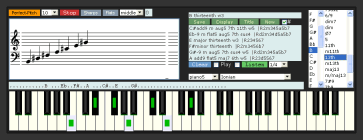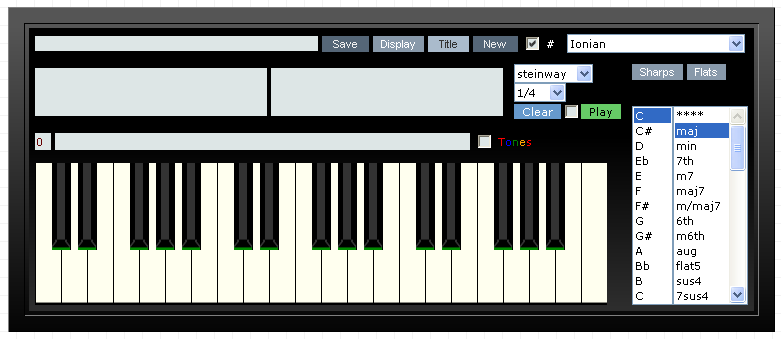Find the name of any chord!
Just move your mouse over a note position on the keyboard and click on it to include the note in the chord.If you click on a note already in place... it will remove it
(when you click notes in and out on the keyboard the "Key, Chords and Modes" drop downs are irrelevant).
Key, Chords and Modes drop downs ...
If you click in a select box for key, chord or scale it displays correct notes and fingering.If you double click without moving the mouse cursor arrow, the textbox
will become highlighted and then you can use the up and down arrows of the keyboard (the one you type on) to change key, chord and scale variations. Modes will only come into effect when clicked on and will use whatever key you select. When you use modes (scales)... the chord type select box is irrelevant.
(although any modes setting in the display boxes is actually irrelevant when clicking on notes and finding chord names... if you click in some scale then remove a note or two, the chords you see will be based on that scale).
Anything is possible...
Whatever displays as the shortest chord name is usually (not necessarily) the best option to use, unless it says "11th" or "13th" somewhere in the display , then that is probably the chord in question and it's showing you what notes are also included in the chord. When it says 11th or 13th it means there is also a 7th included in the chord (any valid 9th, 11th or 13th chord also has a 7th in it), ... the rest of the chord names shown are the program forcing a chord name out of every single note that was picked in the chord. This program will tell you exactly what's in the chord, if's and's and but's. For instance if you're showing a minor chord (minor third) but you also have the third in it, it will say so... m w3 || Rm33 (root, minor third, with 3) ... anything that is usually in a chord but now omitted is x'd out... no5 no3 etc..
"m" : in the result means minor chord or minor third (augmented 9th and minor third are the same notes),
You can click on any name found then edit it in the top box (the default) to anything you want and it will be used in the print display. This allows for anything you can think of.
| root |
2nd |
3rd |
4th |
5th |
6th |
7th |
What's with all the colors?
Click one, find out.
|
Rd22m334d55a56b77
The display after the chord name...
|| R is the Root, then the exact notes usedinthe chord.
Here's the whole shebang || R, d2, 2, m3, 3, 4, d5, 5, a5, 6, b7, 7,
That's Root , dim second, second, minor third, third, fourth, dim fifth, fifth, aug fifth, sixth, flat seven (7th), seven (maj7)
If any display in this format has an extra (more than one) 2, 5, or 7 in it, i.e. d22, 5a5, b77, you can usually rule it out.
m33 mightactually be something because augmented 9th and minor third are the same notes
example... "C seventh sharp ninth" is a valid chord... C 7th aug9 w3|| Rm335b7
Clear | Sharps | Flats |
This Clear will clear the display only
Default setting for program note display is most common enharmonic value...
C , C# , D , Eb , E , F , F# , G , Ab , A , Bb , B
if you want to overwrite this form and display only sharps or flats, click your choice
save | display | title | reset :
Anytime you find a chord or scale you like click "save". When you have all the chords and scales you want click "display" and you'll be able to print or save the page. To start over or make
a new page... click "reset" and it will reset the print page.
If the # octothorpe is checked the black keys in the print display will be that |#| symbol. If un-checked it will display a black box █ in print, it looks nice but not all computers have it.
If you want your name or a title on the page click ...
title
2(9) : a ninth note (the same note
as second). If you add the 9th note to any chord it would be
considered an "add9" chord.
In an true "ninth" chord the "flat seventh" is also included
1, 3, 5, b7, 9 (in
a "C9th" or "C7th" chord the "flat 7th" or "b7"...usually just called "7th"is
a "Bb or A# note").
Any chord that says major... "major ninth", "major thirteenth"
means the seventh note has been raised
1, 3, 5, 7, 9 (not the ninth or the
thirteenth). If the program shows"9" in the display
it means the 9th note (or 2nd) is included in the chord. If the
program shows something like "minor ninth" you've actually found a
true ninth chord variation.
2(9) mnemonic memory device: 2 + 7 = 9
4(11) : an eleventh (the same note as fourth).
In an true "eleventh" chord
1, 3, 5, b7, 9, 11 the ninth and the flat seventh are also included but the 5th and 9th or the 3rd and 5th are usually omitted
4(11) mnemonic memory device: 4 + 7 = 11
6(13) : the thirteenth (the same note as sixth),
A true "13th" chord includes the...
1, 3, 5, b7, 9, 11, 13 (seven different notes)
but the 5th and the 9th or the 9th and the 11th are commonly omitted from chord.
6(13) mnemonic memory device: 6 + 7 = 13



